Episode 6
Ink: Accidental glimpses are the catalysts for most of the plot points in this episode. Kasuga has been seen with Saeki on their date, news of which sends the class into a tizzy of curiosity and disbelief. Out the corner of his eye while traipsing down a hallway, Kasuga catches Nakamura getting friendly with Saeki. And later on, Saeki comes across Nakamura and Kasuga having an intimate discussion in the school library. There are moments of apprehension throughout the first half of the episode stemming from those first two glimpses, but overall the tone is light, almost exuberant, nearly reflecting your run-of-the-mill rom-com. But the brilliance of this show’s execution lies in is its use of layers and contrasts, and the latter, made possible by a cunningly placed lunch scene, is what makes this episode epitomize balance.
Accidental glimpses are the catalysts for most of the plot points in this episode. Kasuga has been seen with Saeki on their date, news of which sends the class into a tizzy of curiosity and disbelief. Out the corner of his eye while traipsing down a hallway, Kasuga catches Nakamura getting friendly with Saeki. And later on, Saeki comes across Nakamura and Kasuga having an intimate discussion in the school library. There are moments of apprehension throughout the first half of the episode stemming from those first two glimpses, but overall the tone is light, almost exuberant, nearly reflecting your run-of-the-mill rom-com. But the brilliance of this show’s execution lies in is its use of layers and contrasts, and the latter, made possible by a cunningly placed lunch scene, is what makes this episode epitomize balance.
 It’s in that same scene where the anime once again improves upon the manga. Nakamura probes into the lovebirds’ feelings and poses a hypothetical to Saeki that triggers Kasuga’s discomfort at being simultaneously confronted with both sides of his nature. Saeki seems more disturbed at the oddity of Nakamura’s “joke” and the intensity of the line of questioning as opposed to harboring any possibility of truth to the invasive question. In the manga, Saeki’s reaction is drawn to be one of cluelessness and befuddlement, whereas the acting and direction in this episode add just that much more depth to Saeki’s character. Another impressive bit of acting (although to much lighter effect) comes from Kasuga in the form of an extended cowardly whimper-scream, which is elicited by a boo-scare that takes 45 seconds to set up and made me laugh for a good long time.
It’s in that same scene where the anime once again improves upon the manga. Nakamura probes into the lovebirds’ feelings and poses a hypothetical to Saeki that triggers Kasuga’s discomfort at being simultaneously confronted with both sides of his nature. Saeki seems more disturbed at the oddity of Nakamura’s “joke” and the intensity of the line of questioning as opposed to harboring any possibility of truth to the invasive question. In the manga, Saeki’s reaction is drawn to be one of cluelessness and befuddlement, whereas the acting and direction in this episode add just that much more depth to Saeki’s character. Another impressive bit of acting (although to much lighter effect) comes from Kasuga in the form of an extended cowardly whimper-scream, which is elicited by a boo-scare that takes 45 seconds to set up and made me laugh for a good long time.
David: 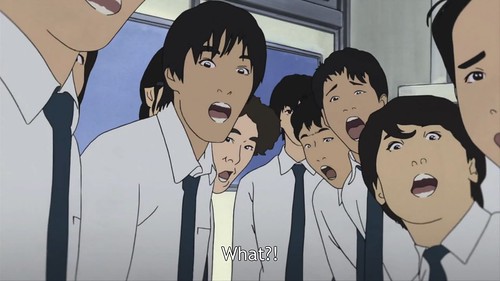 I’m actually not sure which scare you are referring to, Ink, as Kasuga spends the entire episode quaking in terror as a response to anything discomforting in the slightest. Is it the instance when Kasuga has his voice crack in front of the entire class? Is it when Nakamura grabs Kasuga from behind as he trembles before the buzzer to Saeki’s house? It doesn’t really matter since both situations were good for a laugh. I do wish Kasuga were portrayed as something more than this quivering mass that communicates feelings by shouting and sputtering, but it can’t be helped.
I’m actually not sure which scare you are referring to, Ink, as Kasuga spends the entire episode quaking in terror as a response to anything discomforting in the slightest. Is it the instance when Kasuga has his voice crack in front of the entire class? Is it when Nakamura grabs Kasuga from behind as he trembles before the buzzer to Saeki’s house? It doesn’t really matter since both situations were good for a laugh. I do wish Kasuga were portrayed as something more than this quivering mass that communicates feelings by shouting and sputtering, but it can’t be helped.
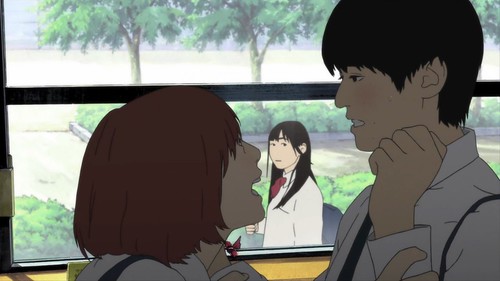 As uneventful as the episode is, it works a lot better in execution than anything before it. The usage of repetition in framing was obvious before, but it seems to be actually working towards an idea now. The method isn’t what I would call elegant, but hammering in the mundanity of attending school in the countryside is setting up an important point that the story confronts later on. There’s nothing remarkable being done in this episode, but it’s the first in a long while that doesn’t rely on bizarre shifts in tone and screaming to establish mood and move the plot.
As uneventful as the episode is, it works a lot better in execution than anything before it. The usage of repetition in framing was obvious before, but it seems to be actually working towards an idea now. The method isn’t what I would call elegant, but hammering in the mundanity of attending school in the countryside is setting up an important point that the story confronts later on. There’s nothing remarkable being done in this episode, but it’s the first in a long while that doesn’t rely on bizarre shifts in tone and screaming to establish mood and move the plot.
Episode 7
David: I really don’t know what to say. I refuse to animeblog this episode in fear of doing it a disservice with my words. Flowers of Evil is still not a good show, but the last five minutes of the episode is possibly the best anime of Spring 2013.
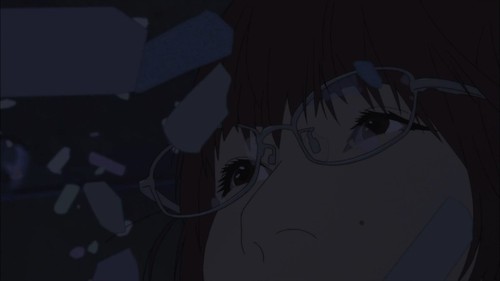
Ink: Kasuga enters Saeki’s home to deliver a handout but with hidden hopes of dispelling any possibility of truth behind what Nakamura said about Saeki’s motives in her relationship with him. Kasuga’s stuttering finally fits in as the typical nervous youth meeting the mother of his girlfriend, and the actress who plays Saeki’s mother offers a very natural, unspoken portrayal of recognition of Kasuga’s nerves. Saeki’s attempts to feel out how exactly Kasuga defines a relationship and assuage her own suspicions about his relationship with Nakamura.
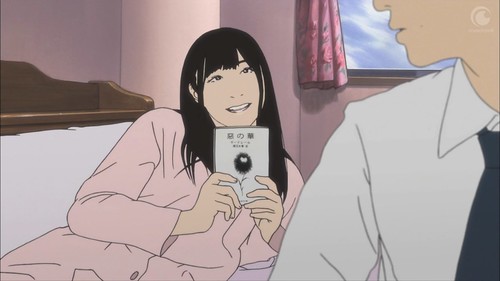 Kasuga cannot believe his misfortune in Saeki’s trust, however. His angel’s faith in such a perverted soul as his own brings Kasuga to his knees in front of Nakamura for his long-overdue penance. Nakamura, devil that she is, agrees to help him, but the contract has a footnote or two that doesn’t let Kasuga let himself off the hook. This leads to what David mentioned: the last scene. Is it a mating dance? a ritual sacrifice? a celebration of youth? of rebirth? Yes. All of those things, in slow motion, backed by a bongo-rific version of ASA-CHANG & JUNRAY’s “A Last Flower,” come together for an utterly amazing climax of reckless abandon.
Kasuga cannot believe his misfortune in Saeki’s trust, however. His angel’s faith in such a perverted soul as his own brings Kasuga to his knees in front of Nakamura for his long-overdue penance. Nakamura, devil that she is, agrees to help him, but the contract has a footnote or two that doesn’t let Kasuga let himself off the hook. This leads to what David mentioned: the last scene. Is it a mating dance? a ritual sacrifice? a celebration of youth? of rebirth? Yes. All of those things, in slow motion, backed by a bongo-rific version of ASA-CHANG & JUNRAY’s “A Last Flower,” come together for an utterly amazing climax of reckless abandon.
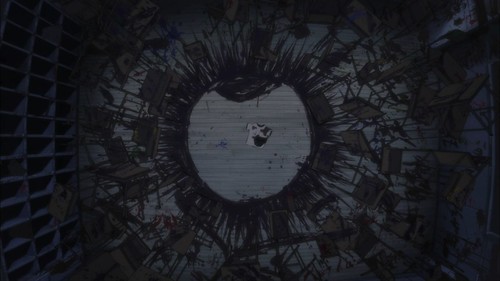
Episode 8
Ink: I’m usually one to defend a slow pace, but director Hiroshi Nagahama makes some poor decisions early on in this episode. Or rather he makes the same mistake multiple times. The opening (non-recap) scene, Nakamura and Kasuga on their way home, exhausted, sated from their midnight debauchery, is necessary. There is no dialog; only a hovering ambient score backs the deviants as they walk onto a pedestrian overpass, and a single shot is held as they traverse the walkway and exit into the distance. Even though the actors/rotoscoping produce a zombie-ish feel to the characters’ sluggishness, it’s a great scene that lasts for a little over two minutes. And then the same thing happens for every stretch of road they walk down. After six solid minutes of this (no joke), the episode begins.
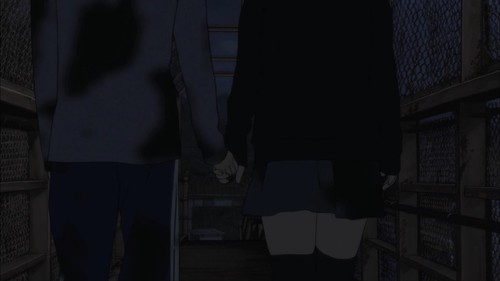 Later on, there’s more dialog-free walking, but this time it has great purpose: revisiting Kasuga’s initial trek to school in the first episode but replacing a steady ambience with a building, malevolent score. It’s clear Kasuga has turned a page. Aside from the walking scenes, the episode seems to fly by abetted via the strongly wrought sense of anxiety – not only anticipatory but reactionary; the difference between how Kasuga imagines his discovery as the pervert perpetrator will play out versus the reality of meeting Saeki before entering the classroom adds just enough shock to throw what little resolve he had out the window.
Later on, there’s more dialog-free walking, but this time it has great purpose: revisiting Kasuga’s initial trek to school in the first episode but replacing a steady ambience with a building, malevolent score. It’s clear Kasuga has turned a page. Aside from the walking scenes, the episode seems to fly by abetted via the strongly wrought sense of anxiety – not only anticipatory but reactionary; the difference between how Kasuga imagines his discovery as the pervert perpetrator will play out versus the reality of meeting Saeki before entering the classroom adds just enough shock to throw what little resolve he had out the window.
David: I’ve complained about the pacing and dead air the show is suffuse with, but I’m going to argue that those six minutes of walking through an empty town are completely necessary. I’ll take it one step further and say that the walking scene would have been the best scene in the show thus far if it weren’t for the end of episode seven. For once, Flowers seems to finally get the kind of intelligent and serious work it wants to be. Don’t get me wrong, I’m not saying Flowers is an intelligent and serious work. What I’m trying to say is that the director imitates Tarkovsky so well that I can’t help but to be impressed at how deftly it avoids the pitfall of pretentiousness.
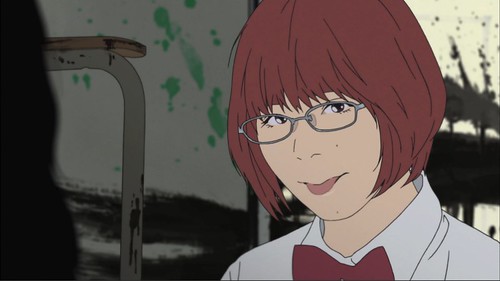 Of course, Flowers can’t be all magical moments like these, so we’re eased back into the usual paces of the show. Kasuga continues to freak out as he watches his life spin out of control and Nakamura retreats behind the wall she’s erected separating her from her classmates. Despite their revelation of the truth behind Saeki’s gym clothes, they don’t seem ready to confront the world yet. These are different characters now, but they aren’t behaving differently, not until those around them, particularly Saeki, figure out what their deal is.
Of course, Flowers can’t be all magical moments like these, so we’re eased back into the usual paces of the show. Kasuga continues to freak out as he watches his life spin out of control and Nakamura retreats behind the wall she’s erected separating her from her classmates. Despite their revelation of the truth behind Saeki’s gym clothes, they don’t seem ready to confront the world yet. These are different characters now, but they aren’t behaving differently, not until those around them, particularly Saeki, figure out what their deal is.
Episode 9
David: 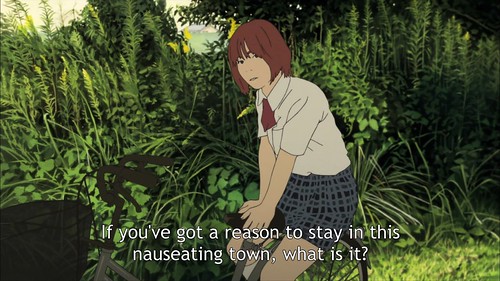 Unable to keep anymore secrets from his girlfriend and his mom, Kasuga figures it’s finally time for him and Nakamura to run away from home and see just what lies beyond the mountains that encircle their dull town. I have to say, I’m really surprised to see a second consecutive episode reliant on quieter moments of tension that actually works well, considering how inconsistent the pacing and direction has been at getting it right. Since the show is winding down towards the end of broadcast, it all seems much more focused. The creator’s finally grasp the rotoscoping technique and the beats for movement and non-movement, even with an abundance of still shots that had me worried my stream broke. Call it Stockholm Syndrome, but it almost feels nice to look at, as if I’m beginning to see the
Unable to keep anymore secrets from his girlfriend and his mom, Kasuga figures it’s finally time for him and Nakamura to run away from home and see just what lies beyond the mountains that encircle their dull town. I have to say, I’m really surprised to see a second consecutive episode reliant on quieter moments of tension that actually works well, considering how inconsistent the pacing and direction has been at getting it right. Since the show is winding down towards the end of broadcast, it all seems much more focused. The creator’s finally grasp the rotoscoping technique and the beats for movement and non-movement, even with an abundance of still shots that had me worried my stream broke. Call it Stockholm Syndrome, but it almost feels nice to look at, as if I’m beginning to see the  perfect reasoning why the show looks the way it does. There’s some criminally underappreciated depth of focus effects that happen all throughout the show that could easily just be in there because the shot looked that way in real life. As brief and infrequent as these shots are, they give the show that sense of reality it’s been chasing after since it started.
perfect reasoning why the show looks the way it does. There’s some criminally underappreciated depth of focus effects that happen all throughout the show that could easily just be in there because the shot looked that way in real life. As brief and infrequent as these shots are, they give the show that sense of reality it’s been chasing after since it started.
Ink:  Usually Flowers is intricately scored or at least backed with ambient sound, so those moments comprised of complete silence and still shots that David mentioned can definitely bring a viewer out of the experience. Keep in mind, this is not a fault in the composition of this series; the effect would work great if watching on DVD/BD. Rather this is a continuity fault incurred by being conscious of watching something so fragile via such a temperamental and untrustworthy delivery vehicle as a streaming service.
Usually Flowers is intricately scored or at least backed with ambient sound, so those moments comprised of complete silence and still shots that David mentioned can definitely bring a viewer out of the experience. Keep in mind, this is not a fault in the composition of this series; the effect would work great if watching on DVD/BD. Rather this is a continuity fault incurred by being conscious of watching something so fragile via such a temperamental and untrustworthy delivery vehicle as a streaming service.
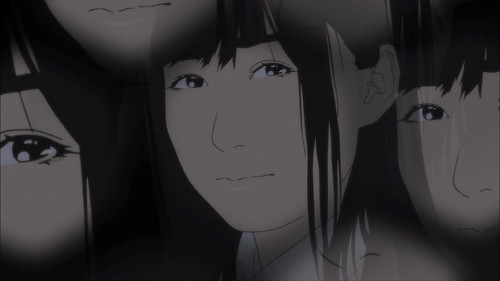 As stunning as the visuals in this show are and have always appeared to me, I do take issue with choice shots. Case in point: Saeki kaleidoscope vision, which misses what the manga was trying to accomplish. While dizzying, it doesn’t evoke the same portrayal of disappointment and shame the panel on the page manages to do so adeptly. As usual, however, the series makes up for its shortcomings with, say, the shot of Saeki’s subdued disgust at Kasuga’s absence from class. That look is evocative of a strong will. This contradicts how she explained herself earlier, but it’s nice to see her rising intolerance in being treated as she is.
As stunning as the visuals in this show are and have always appeared to me, I do take issue with choice shots. Case in point: Saeki kaleidoscope vision, which misses what the manga was trying to accomplish. While dizzying, it doesn’t evoke the same portrayal of disappointment and shame the panel on the page manages to do so adeptly. As usual, however, the series makes up for its shortcomings with, say, the shot of Saeki’s subdued disgust at Kasuga’s absence from class. That look is evocative of a strong will. This contradicts how she explained herself earlier, but it’s nice to see her rising intolerance in being treated as she is.
Along with select shots, the difference between the language in the manga and the series seem weak in some instances and therefore detrimental to the air of this episode. Though I’ve had issues with select passages before, overall this episode needs the edge evoked by the harsher language the manga employs.
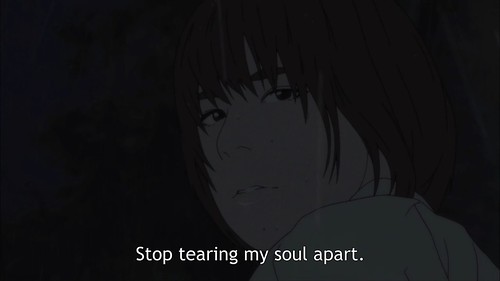
Flowers of Evil is now streaming on Crunchyroll.
